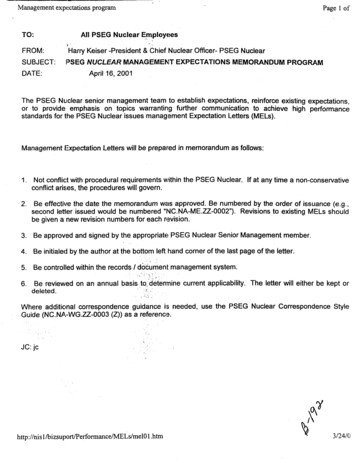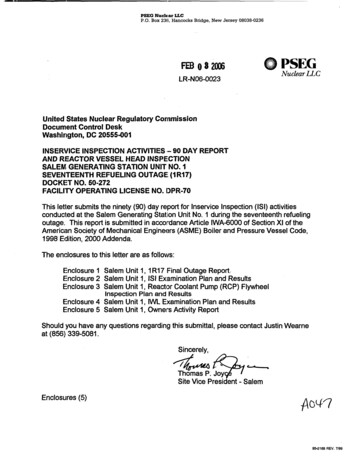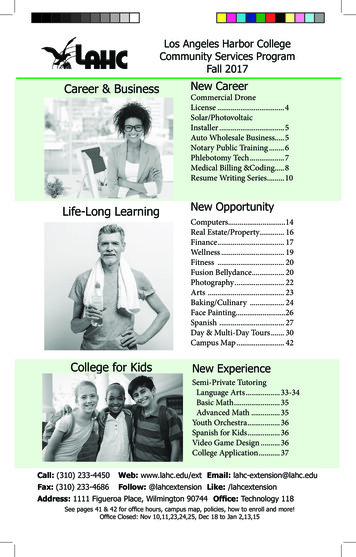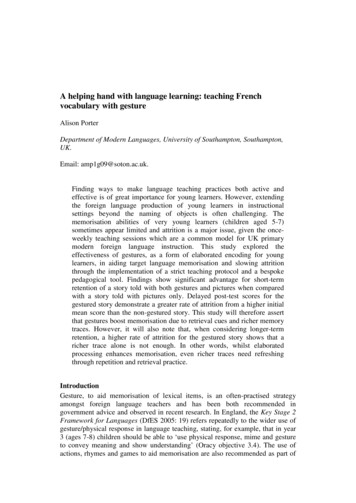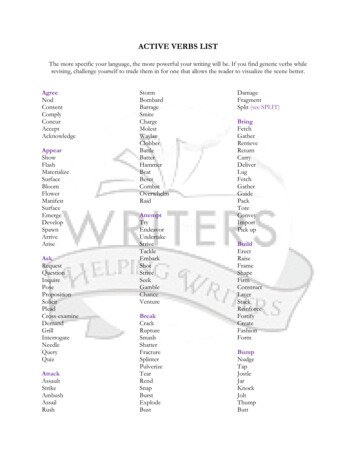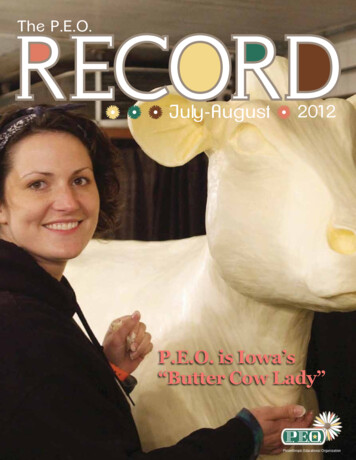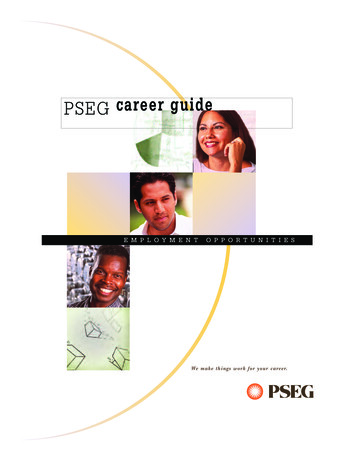
Transcription
PSEG career guideE M P L O Y M E N TO P P O R T U N I T I E SWe mak e t hi ng s wo rk f o r yo ur career.
PSEG CAREER GUIDEco n t e n t sResume Writing1Resume Guidelines2Fact Sheet and Test Taking Tips6CAST Test and Gas Battery Test Sample Questions*8Graphic Math8Spatial Relations15Mechanical16Arithmetic Reasoning19Reading Speed & Comprehension22Other Study Guides for CAST and Gas Battery Test32Sample Test Questions for Meter Reader Test*33Engineering Technician Test Sample Questions34POSS/MASS Test Sample Questions36Typical Entry Level Positions for Skilled or Craft WorkersJob Duties of Division Mechanic Assistant38Job Duties of Utility Mechanic Apprentice41Job Duties of Appliance Service Apprentice43Job Duties of Customer Service Representative44Information About Customer Service Positions46Answers47Interviewing Tips49This revised career guide was put together by the Workforce Diversity Management team at PSEG, with support from the HR Testing and Assessment staffto aid employees and non-employees in gaining entry into our frequently filled entr y-level positions. We hope you find it to be a useful tool.* Content of sample questions are for study purposes only and it should not be construed that these are the actual types of questions that will appear onyour PSEG test. Studying for the test(s) using this guide does not guarantee passing our test(s).This career guide is not a contract. It does not contain promises of any kind nor gives any guarantees of employment. The employment relationship betweenthe company and its employees is employment at will. Nothing in this guide changes or alters that existing employment relationship. The informationcontained herein may be changed or withdrawn at any time without advance notice. The company maintains the right to apply or administer its practices,policies, programs or procedures as it deems necessary.
RESUME WRITINGresume best practicesTo make your resume as readable as possible in PSEG’s database, it is preferable that you:n Use a 12 point fontn Use a standard font (like Times New Roman)n No boldingn No underliningn No italicsn Use plain white papern Use 8.5 x 11 size papern All resumes must be submitted via PSEG’s website: www.pseg.comresume writing tipsn Proofread everything – a resume without errors is very important.n Be sure to include volunteer and extra-curricular activities on your resume, especially if theyrelate to your chosen career, or if they reflect positive personality attributes. This could includeactivities in your community, or skills that you have demonstrated in your neighborhood or athome (i.e., repairing your neighbor’s heater, installing a dishwasher).n Try to limit your resume to one page. Keep it short and to the point.n Only include an objective if you are very focused in your job search. You might consider usinga Summary of Skills or Summary of Qualifications to really highlight your skills.n Include all pertinent information on your resume. For instance, if you drive a tractor-trailer fora living, rather than just talking about your truck driving, make sure you mention that youhave a CDL (commercial driver’s license).1
RESUME GUIDELINESThis guide was created to assist candidates in exploring aspects of their work/life experiences that canbe translated to specific skills and knowledge that may be of interest to employers. Ask yourself thefollowing questions when preparing a resume:Communications /Customer Service Skillsn Have you ever handled customer inquiries over the phone or face-to-face?n Have you ever analyzed, re-directed and/or solved these inquiries?n Have you ever used a switchboard?n Do you have strong keyboarding skills?n Have you had experience with answering calls and navigating through a computerapplication to address the call?n Have you had experience speaking to a group? For example: a company meeting/forum,community or social meeting/forum, faith-based meeting/forum, school presentations?n Do you have good writing skills?Organizational/ Management Skillsn Do you oversee/check other associates’/contractors’ work?n Do you have anyone working under you? (e.g., an assistant )n Do you have project management skills?Technical Skillsn What sophisticated equipment/tools do you know how to use? (e.g. volt meter, specialgauges, fork-lift, crane, certain power tools, any testing equipment in general) What are they?n Do you have experience in computer applications? What are they?Team player/Leadership skillsn Are there a lot of interactions in the type of work you do?n Have you been in charge of committees or team projects?n Have you ever organized a function or activity at work? In the community? In a faith-basedorganization? Recreation center? etc.2
RESUME GUIDELINEScontinuedCertifications/Licenses/ Seminars / Workshopsn Mention the name and location of the course/program or seminar. Briefly describe whatyou learned or what license or certification resulted. (e.g., safety/OSHA, welding, computerapplications/programming, boiler seals, conflict management, leadership sn Mention business, social, educational, faith-based, or community organizations activity.n What honors/awards have you received (e.g., volunteer work, community work,winning/finishing a marathon, etc.) If not self-explanatory, briefly describe theachievement.Categorize and combine as you see fit to personalize your resume. Your skills and experience do nothave to come only from your employment history. They can be described as “life experience.” In otherwords, you may have certain skills you have used when doing volunteer work, community/publicwork, faith-based work, neighborhood-related work, etc.3
sample sample sample sample sample sample sampleJOHN DOE123 Walnut StreetAnytown, NJ 45678(201) 555-5555johndoe@xyz.comOBJECTIVE:To continue working in the field of HVAC where I can grow and learn newskills relating to the repair of appliances, heaters, and air conditioners.SUMMARY OFA skilled craftsperson with 6 years of experience working on smallQUALIFICATIONS: business and residential HVAC units. Type II refrigerant certification.EMPLOYMENT:1999-present ABC Air ConditioningAnytown, NJAssistant Service TechnicianAnnual maintenance of residential and small business heatingand air conditioning equipmentInstallation of HVAC units and furnaces, including duct work and wiring.Soldering and brazing of line sets and black piping.High and low voltage electrical wiring.Troubleshooting by using volt meter and checking electrical current, etc.Recover and reclaim refrigerant and evacuate system.Re-piping and changing of water heaters.1996-1999EDUCATION:1995-1996GraduatedXYZ and Son, Inc. HVAC CompanyAssistantInstallation and service of HVAC unitsSoldering and brazing of copper pipingElectrical wiringTroubleshooting by using volt meterParts retrieval and replacementRecover and reclaim refrigerantMaintenance of suppliesAnytown, NJLincoln Technical InstituteMajor – HVACMahwah, NJ4
sample resume of someone who has just finished trade schoolLisa Doe987 Main StreetAnytown, NJ 12345(609) 555-5555lisadoe@xxx.comOBJECTIVE:To become an apprentice in a skilled trade.Mechanically-oriented individual, having graduated from vocationalSUMMARY OFQUALIFICATIONS: technical school in the field of electromechanics. Also skilled in electricalwiring and plumbing, as I have assisted family and friends in theseendeavors, and also in my volunteer work.EDUCATION:Gloucester County Adult Vocational Technical SchoolElectromechanical Certificate – June 2002Camden High School, 3.0 GPA – diploma, June 1999EMPLOYMENTHISTORY:1999-present Burger KingJonestown, NJ- Assistant Manager- Helped manager in supervisory duties such as monitored inventory,ensured cleanliness of restaurant, proved registers- Prepared food for customers- Greeted customers and processed orders1997-1999OTHER ACTIVITIESAND COURSES:Mowed lawns during the summer for people in my neighborhood.Volunteer for Habitat for Humanity, helping out with the wiring andplumbing1999-presentOSHA in the Workplace Course – Certificate of Completion 2000The above resume is of someone who might be considered for a position as a division mechanic assistant or utility mechanicapprentice - see pages 38-42 for job specifications.5
FACT SHEETANDTEST TAKING TIPSMost of PSEG’s trade positions, in addition to our customer service and meter reader positions, requirethat candidates take (validated) pre-employment tests to enter apprenticeship training. In order toassist in this endeavor, we’ve compiled helpful tips to ease applicants through the process.facts about PSEG’s testsPSEG’s tests, except the meter reader and customer service tests, include sections on readingcomprehension, math skills, and problem solving. In general, reading comprehension and math skillsare basic skills for test taking success. Try timing and challenging yourself on these skills. Seek out testpreparation guides that include practice tests. Some suggestions are included in this guide or you cancheck with your library or the Internet for these guides.The meter reader test focuses on speed combined with accuracy. It is necessary to identify the tablesthat match sets of listed numbers. Concentrate and focus on being quick and accurate. If you decideto apply, bring your confidence with you, as well as your concentration. See Page 33 for a meterreading practice test.The customer service test, which is required for all in-office customer service positions, requires strongkeyboarding skills, some basic math as well as the ability to read carefully and follow instructions.First, your speed and accuracy in entering text will be assessed. Second, your skills in enteringinformation regarding new service and power outages will be measured. Last, your ability to answerquestions on customers’ bills and bill complaints will be assessed. You will be given full instructionsand practice prior to each section. Practice at home by performing many consecutive tasks -- liketyping a document, making a phone call, and then toggling to a spreadsheet -- then start over.The tradespersons apprentice programs tests include sections on graphic arithmetic and mechanicalconcepts, in addition to reading comprehension and mathematical usage. In the graphic arithmeticsection, it is necessary to look at drawings and answer questions that can be derived from thedrawings, such as the distance between two points or the surface area of a rectangle. In themechanical concepts section, there are questions that relate to physics.The reading comprehension section requires reading a paragraph and then answering questionsabout what was read.6
ADDITIONAL TEST TAKING TIPSANDTEST RELATED INFORMATIONThe mathematics section measures an applicant’s ability to work with formulas, like converting quartsto gallons. See the sample questions provided in this guide.The Engineering Technician test includes sections on graphic problem solving, interpreting diagrams,mechanical concepts and reasoning from rules. See the sample questions provided in this guide.The Plant Operator Selection System (POSS) and Power Plant Maintenance Position Selection System(MASS) tests are used to select candidates for operating and maintenance jobs in Fossil, Nuclear andPower plants. Sections of the tests include items measuring reading comprehension, mechanicalconcepts, mathematical usage and spatial ability. See the sample questions provided in this guide.test-taking tipsn Get enough sleep the night before and eat before taking the test.n Allow plenty of time to arrive to the test site early.n If you feel nervous, try a breathing exercise to help you relax.n Dress comfortably.n Work as quickly and as accurately as possible. It is a good idea to skip over questions thatare taking too long to answer. If you skip a question, make sure you skip the correspondingquestion on the answer sheet. Make sure you go back later if you have time.n Listen carefully to the test administrator and carefully follow the instructions for the test.n If a particular test has ‘no penalty for guess,’ try completing as many questions as possibleas you will not receive credit for unanswered items.n If you wear glasses for reading, make sure you bring them with you to the test.You may find additional information on PSEG’s pre-placement tests by going to www.pseg.com/careers.There is a link to PSE&G practice tests that can be used as a reference.7
CAST TESTOR GASgraphic mathBATTERY TEST SAMPLE QUESTIONSA R E A a two-dimensional measurementthe area of a rectangle is found by multiplyingthe two dimensions, length and width.lengthwidthArea units are squared length units, for example, in2, mi2, ft2, cm2, m2, etc. The reason for this lies in thecalculation of the area. To find the area of a 12 ft x 18 ft wall, the formula calls for the multiplication ofthe length times the width. The numerical part of the calculation is 12 x 8 96, but the unit of eachdimension must also be multiplied. In this problem, the unit calculation is ft x ft ft2. When noexponent is shown on a number, variables or units are multiplied, the exponents are added, so, anotherway to look at the unit calculation would be:ft1 x ft1 ft 1 1 ft2The unit calculation does not need to be done separate from the numerical calculation, the problemabove was to demonstrate a point. Keep this in mind that the units must be the same {ft x ft, in x in,etc.} before they can be multiplied together. Be sure to convert all given unlike units to like unitsbefore proceeding with the calculation.To calculate how many square inches are in a square foot, recall that there are 12 inches in one foot,then square both sides of the equality:( 1 ft )2 ( 12 in )2( 1 ft ) ( 1 ft ) ( 12 in ) ( 12 in )1 ft2 144 in2To calculate the number of square feet in a square yard, recall that there 3 feet in one yard. Now squareboth sides of the equality:( 1 yd )2 ( 3 ft )2( 1 yd ) ( 1 yd ) ( 3 f
- Re-piping and changing of water heaters. 1996-1999 XYZ and Son, Inc. HVAC Company Anytown, NJ Assistant - Installation and service of HVAC units - Soldering and brazing of copper piping - Electrical wiring - Troubleshooting by using volt meter - Parts retrieval and replacement - Recover and reclaim refrigerant - Maintenance of supplies EDUCATION:
